"In 2018 Influx brought you more cars, bikes, people and culture than ever before. What was your highlight? We featured everything from home-built bikes in our VC London film, and completely bespoke cars like Charles dos Santos' V8-powered Nissan drift "
Humanity – Influential People
Some of the amazing people we've met along the way.
Cars are all about people. It’s obvious really – but at times this simple truism can get lost. With the obsession with speed, power, style and design – with the object itself, you can forget that there is nothing more human than the machine.
And with the current strange situation the world is facing, the simple fact of the humanity of the heart of what we do at Influx has been brought to the forefront.
With this in mind we thought it timely for us to focus on some of the fascinating people we have met on the Influx journey. We have done our best to tell authentic stories about them and the things they have done. And almost by accident, we realised that our pick of five people are a fistul of some of the most influential folk in the culture.
The Aficionado: Magnus Walker
In 2015 we met Porsche aficionado Magnus Walker at his home and workshop – a converted industrial unit in Downtown Los Angeles. His gobsmacking collection of 911s – many of them rebuilt from the ground up by his own hand – was of course impressive. But what struck us most about the Sheffield-born self styled ‘rebel outlaw’ was his relaxed humility. There was a glint in his eye that spoke not only of an obsession indulged, but of a dream realised.
And it’s that chasing of the dream that motors our love of cars and bikes. It’s not so much the physicality of the machines themselves. It’s what they do. it’s where they take us. It’s what they represent.
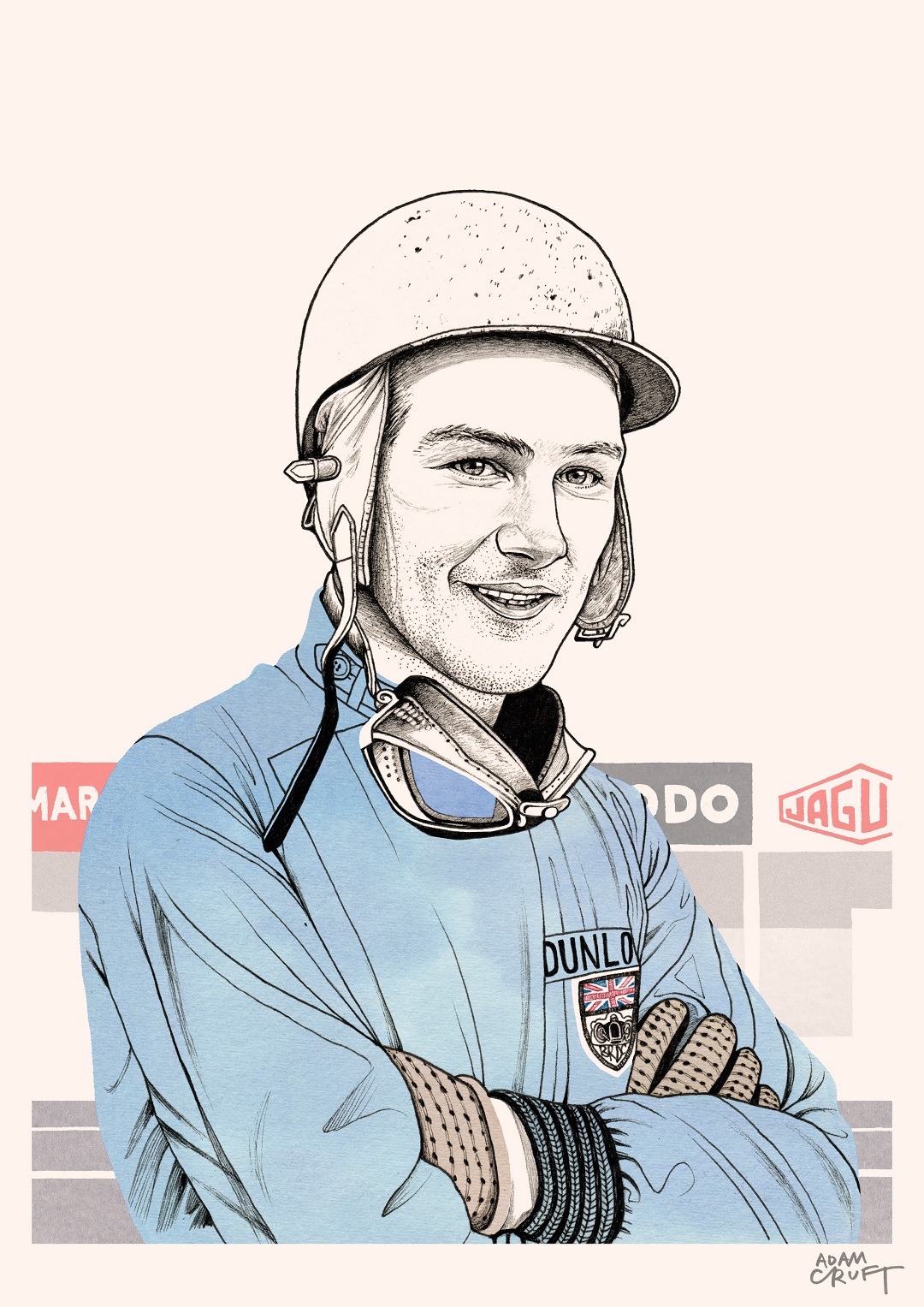
Illustration: Young Stirling Moss: by Adam Cruft – originally commissioned for Influx, April 2020.
The Racer: Stirling Moss
In 2010 I spent an afternoon with Sir Stirling Moss, who died on April 14th, 2020, at his home in London’s Mayfair. The setting was suitably classic. A tasteful mews tucked round the back of the Hilton. Garage doors appropriately fronted the place, and to the side was a smaller front door, which led to a passage up a tight set of wrought iron spiral stairs to the living room where we sat to chat. It was overwhelming. Of course the place was saturated in automotive history. Stirling had lived in this place since the early sixties. It seemed gauche to ask too much about his victories, his battles with Fangio – or even that foreshortened competitive career, which ended before this great driver (arguably the greatest Brit to ever sit behind the wheel) could attain the championship success that he was a natural heir to.
But I did ask him, of course, the usual questions – and he laconically, gracefully answered them as if he’d never heard them before.
He told me about that mad feat of the 1955 Mille Miglia, where with beardy motorsport journo Denis Jenkinson as his wingman he was able to beat the Italians in their backyard and set a mindblowing average speed of a shade under 100MPH, and a last 83 mile section at an average of 165 mph. Yes, on public roads. In 1955. With drum brakes. Without seat belts. (No matter how often you run all that through your mind, the feat doesn’t seem any more feasible).
But what I remember most are Stirling’s hands. They were gnarled but somehow light, almost delicate. They were textured, They were deft. They were powerful. They were the physical extension, somehow, of the soul of the man. These were the hands that steered the Moss legend through a life of impeccable style, talent and grace. Those hands epitomised the twentieth century ideal of a racing driver (British Version). Stirling Moss the dashing but polite daredevil with a glimmer in his eye that reminded you that there was something special, something almost monstrous, about the genius that in 1955 peaked at a height so unassailable.
I remember my favourite quote. “We had a much better time than the likes of Jenson and Lewis”, he said. “We’d get out of the car at the end of a day’s racing and go straight out chasing crumpet. These guys have to go and talk to Vodafone!”

Joonas Vartola (centre) with co founders Jarno Lehtinen (left) and Olli Laaksonen (right)
All Images courtesy Joonas Vartola/Ultra
The Designer: Joonas Vartola
You may not recognise the name of Finnish Designer Joonas Vartola. Joonas is the entrepreneurial founder of Ultra – one of the world’s most dynamic small industrial design houses. But before making the jump toward solo flight Joonas was at the heart of many of the key moments in the design development of the Tesla. We first met Joonas in 2011, when he was graduating from the master’s degree in vehicle design at London’s prestigious Royal College of Art. It was a moment when the design of car interiors were just about to enter the realm of ‘User Experience’ – a term at the time more likely to be heard when talking about websites and social media feeds than dashboards and gear shifters. During Joonas’s time at Tesla the possibility was emerging of the disappearance of the classic objects – the dials, knobs, switches and levers, that had to that point always been at the interface of man and automotive machines. We caught up with Joonas via video call between the locked down cities of London and Helsinki, to talk about where we’ve been in car design – and where we may be going.

When you graduated RCA in 2012, could you have imagined where car design would be right now – and where your career would have taken you?
I don’t think so. Back then I was looking forward to a very long career in the world of Original Equipment Manufacture [OEM]. I definitely didn’t think I would become an entrepreneur. I also didn’t imagine that I would be working between 60-80 hours a week at a company like Tesla in Los Angeles. It was a challenging and fascinating time at that company. In fact it was almost overwhelming. There was so much uncertainty about the future. The company and its founder was (and still is) an underdog in relationship to the mainstream industry. There was so much promise and so much energy to prove what the company was capable of. Working at Tesla helped me to get a handle on the emerging technologies. We were working at the crossroads of Vehicle Architecture and In-Car Experience, as well as building a new brand. We were challenging the critical thinking about the relationships between the interior and exterior design of vehicles, so it was a really fascinating time and was so informative for me about every aspect of both car design and business. Eventually marriage happened, and then kids happened. I realised there must be some other way forward. So I thought that setting up your own company might be interesting. My time at Tesla helped me to think in an entrepreneurial way. The pace was so fast and the pressure was so intense – everything there was shot through with ambiguity that it forced you to be agile in your approach. That kind of experience created a wonderful foundation on which to build my own company. But I couldn’t have predicted such a thing would have happened.
What were your key projects while at Tesla?
When I first started I was working on the key details of Model S, and then started on the Model X program. It was unlike any really established companies. The team was so small – only six designers there when I arrived. We worked all the way through the Model X program from concept to production, then on the Model 3 from concept to production and then on to the early work on the Model Y. I also worked on the Supercharger exterior and design, the charging station architecture and design. So I was there at many of the important moments in the development of the brand.

What were the most important things in terms of design that happened while you were at
Tesla?
By 2016 I was senior exterior designer – but the team was still so small that every designer worked on everything. I therefore worked across the projects, on centre consoles, headliners, steering wheels and columns and everything interior. If there was a problem that needed solving, you jumped there, so this led to a beautiful integration of the design process. I definitely endorse that approach. In order to design really effective products the designer needs to understand both the messages of the interior design and that of the exterior – and crucially the relationship between the two. This understanding of the UX is really key to how Tesla became so important in the design of vehicles.
You’re a Finn who works in the car industry. Driving is in your blood. How do you feel about the sort of driving experience that you get from electric cars with digital interfaces?
I remember feeling this weird sensation when I first got to drive a Model S, as many people do. It felt so different at the time from my BMW five series. Just the instant acceleration and the endless torque was so strange. It was an almost alien experience. But everything afterwards felt old. Everything ever since has felt dated, ancient. Once you’ve experienced the electric powertrain (and it doesn’t have to be one made by Tesla, by the way), you can never experience driving again in the same way. I remember it was almost like a mystical, religious experience. I tried to express that experience to my boss at the time at one of the company’s ‘town hall’ meetings.’ You have to drive one to become a believer. It was so unreal. It felt so digital. I suppose me being a Finn might have heightened the effect!
So do you think it’s necessary, or possible to bring a more ‘human’ experience to electric cars and digital interface?
The traditional car feels organic. You turn on the engine and the heart starts pumping and circulating the oil and the vibrations and the sounds begin. With an electric car it is either on or off, like a light switch and there is little or now sound. That’s the challenge in design. The noise or lack of it is neither good or bad per se… but the noise and the vibrations of a car with an internal combustion engine creates a personal relationship with the product. There is a risk in electric car design, that even with the beautiful materials and fit and finish that we can include, it still feels like a piece of consumer electronics, rather than a vehicle that you can love, a machine with which you can have a lasting relationship. But on the other hand: if you think of a vehicle as a digital platform rather than a machine in the traditional sense, a number of unexplored possibilities and opportunities emerge. How, for example, would it be possible to enhance the digital driving experience? Without the noise and the mechanical aspects of older cars, there is a blank canvas for us as designers. And it’s not just a blank canvas for the sensations we can produce – but also for the architecture of electric cars, the physical structure of the things we can produce. The ‘skateboard chassis’ of the Tesla platform, for example, gives you much more opportunities for interior design. And there are a wealth of unexplored possibilities for what our electric cars can look like too.
With that in mind, what do you see as the next evolution in car design?
The digital revolution, the digitisation of functions etc, is all about interface. But I am not a big fan of touch screens. Design gets better when you notice the technology less. When the Tesla first emerged, people noticed the huge rectangular touch screen in the interior. But I believe that design evolution should become less about certain objects, like a touchscreen (a multifunctional object, but still an object), but more about omnipresence [or ambience]. Technology in our cars and our lives in general will, I think, become more omnipresent, more ambient, more about our humanity, our personality. The technology itself will be more directly linked to our desire for function, rather than mediated by an ‘object’ like a dial, switch, etc. The touch screen is a staging post if you like, toward a moment when technology is seamlessly integrated. The digital transition is an enabler to a better experience where the hardware becomes invisible, or at least intangible.
So what sort of driving experience do you think will be the cutting edge of motoring in the middle of this century?
What I would love to see in the future – rather than autonomous vehicles and cars driven with AI, would be a car that, after only a couple of drives, actually begins to know me, begins to act upon who I am and the choices I make as a human being. I think this would be a true humanising of a machine. We have the means and the technology to make the car become our friend, or a digital avatar of us. Tesla is already doing this at a basic level of course. You’ll be driving your car down a particular road, and of course other Tesla cars have already driven that road, and they are learning the conditions and dimensions and surfaces and other aspects of that road, they are using the information already gathered via other Tesla from the cloud. I would like your car to know you so well that it already knows, for example, that whenever it reaches 23 degrees, that you always put on the AC; that when it detects a certain level of airflow, you always close the window; that when the sun reaches a certain angle in the sky, that you always deploy the sun visor. I think when we get there, then the design and digital transition has reached a point that the interface is not something physical anymore, but it’s becoming discreet and invisible.
And is this happening right here and right now?
In a way yes, it is. For example: the Porsche Panamera has 109 buttons in the interior. The Model 3 Tesla has 14 in total. A drastic drop in the number of functional visual elements has therefore happened already. So if we take such drastic measures in the same space of time as the time between the design of the Panamera and the Model 3 Tesla – what will happen to those remaining 14 buttons – and are they really necessary at all? And if you don’t have them, do you miss them? Do you miss pushing the buttons?
Joonas Vartola is Co-Founder of Ultra

Gary Inman & the faces of Dirt Quake by Michael Fordham
The Publisher: Gary Inman
Sideburn is the most influential indie magazine in the global culture of motorcycles. The aesthetic and tone of voice of the colourful and unruly zine, which is published six times a year from proprietor-publisher and editor Gary Inman’s Lincolnshire backyard, is deeply rooted in these islands. But the stories it tells and the aesthetic it promotes have rippled powerfully around the world. “People have made comparisons between what we do and [California cult skateboard title] Thrasher” Gary tells me from Lincolnshire lockdown. “That makes me smile….”
Despite what you’d think by looking at the magazine, whose masteheaded merch has become totemic of a certain alternative way of being a biker, Gary is a sardonic, understated character. His love of riding motorcycles is clearly intertwined with his very being. He comes across with a very English lack of pretence. He is thoughtful, considered. You can sense a quantum of grit in his soul. Or is that cinder? “I launched Sideburn in 2007 as a way to stretch my creative muscles”, he says. “At the time I was dissatisfied with the work that was being done in the mainstream motorcycle magazines and the sorts of commissions I was getting as a freelance writer. Launching the magazine was my way of telling the stories I wanted to tell about the things that I loved.”
The thing about motorcycles Gary loved most was the then-arcane world of UK Dirt Track Racing (the magazine’s strapline has always been ‘Go fast, turn left’). In 2012 Gary inaugurated the hilarious and spectacular Dirt Quake, the first of an annual series of all-comer oval racing events. “Dirt Quake tried to demystify racing and puncture the macho myths that existed within racing,” he says. “It turned on a whole new demographic to participation motorsport. It gave racing back to the masses, like [Bruce Brown’s film] On Any Sunday did to a much greater degree in the 1970s. Competition had become too specialised and ruled over by people who wanted to make it more and more expensive. The more expensive anything gets, the less fun it is.”
Dirt Quake drew ragged amateur followers of the cult of sideways sliding from all over the world. It was a unique and perilous enterprise — and encapsulated the chaos of the new order perfectly. It must have been an organisational nightmare. Gary sold the Dirt Quake as a piece of’ Intellectual Property’ in 2017. He moved on to concentrate on the magazine – and diversified into organising ride-outs for the like-minded in places like Morocco and Nepal. By then Sideburn had evolved to epitomise the sort of irreverent and welcoming alt.Bike culture that was lodged firmly at the left-field of the world wide motorcycle scene.
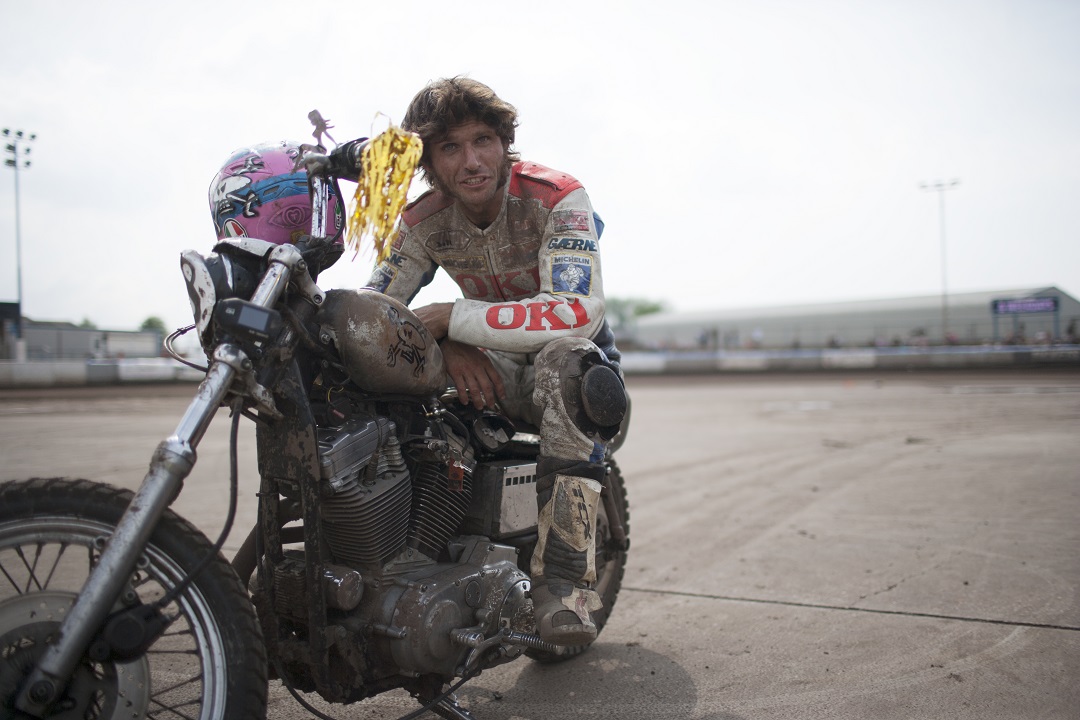
“In terms of business, it’s limpet like survival,” he says. “We’re small and compact, and we like it that way. If you email the mag it’s going to be me who replies. My wife helps me with the mailouts, that’s it. We’re not interested in being mainstream, though I understand how the industry have been influenced by what we have done.” There’s an irony shot through the heart of this whole enterprise. Alt. Bike culture is a behemoth with a heavy dash of American sauce – and its cult zine, not to mention its publisher, could not be more English in its way of being in the world.
“We’ve tried to publish in the states, but it never really works for us”, he says.. “and sometimes I think that if we were publishing there full time we’d probably sell ten times more stuff than we do at at the moment.” Just before lockdown the ink was still wet on a deal for Sideburn to become the official magazine of American Flat Track, the sport’s governing body. “We’ll see what happens with that if we ever emerge from lock down, he says…“but I realised a few years ago, after going to the Mooneyes Show in Japan, that we are actually closer to that Japanese way of doing things than either the American or the English way. We do one thing really well. We keep focussed on our own little corner of the culture and though we might mean little to the huge mass of people out there – if you are into what we do, we mean everything. I realised a long time ago that there are ways to be successful without having to have standards imposed on us from the mainstream.”

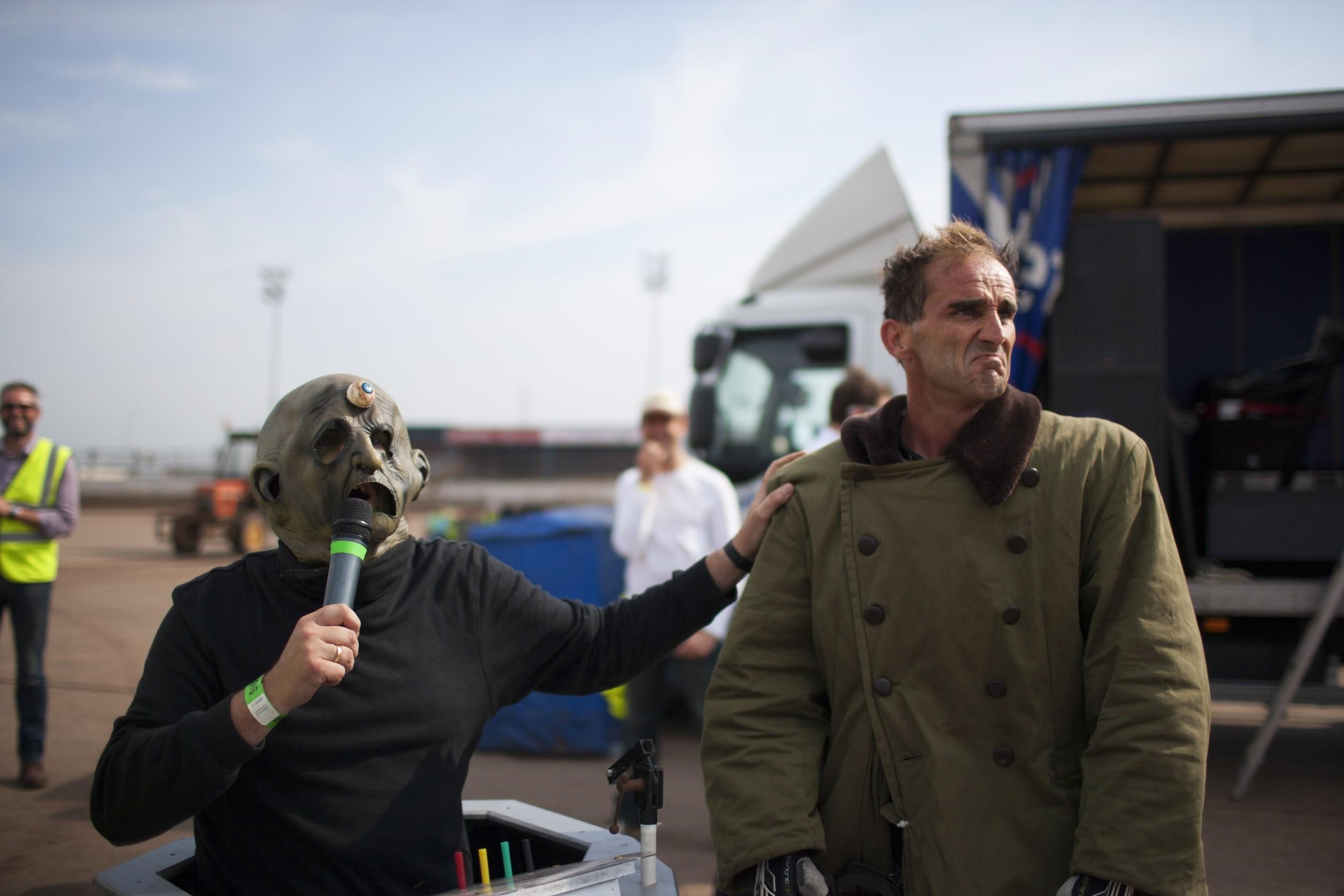
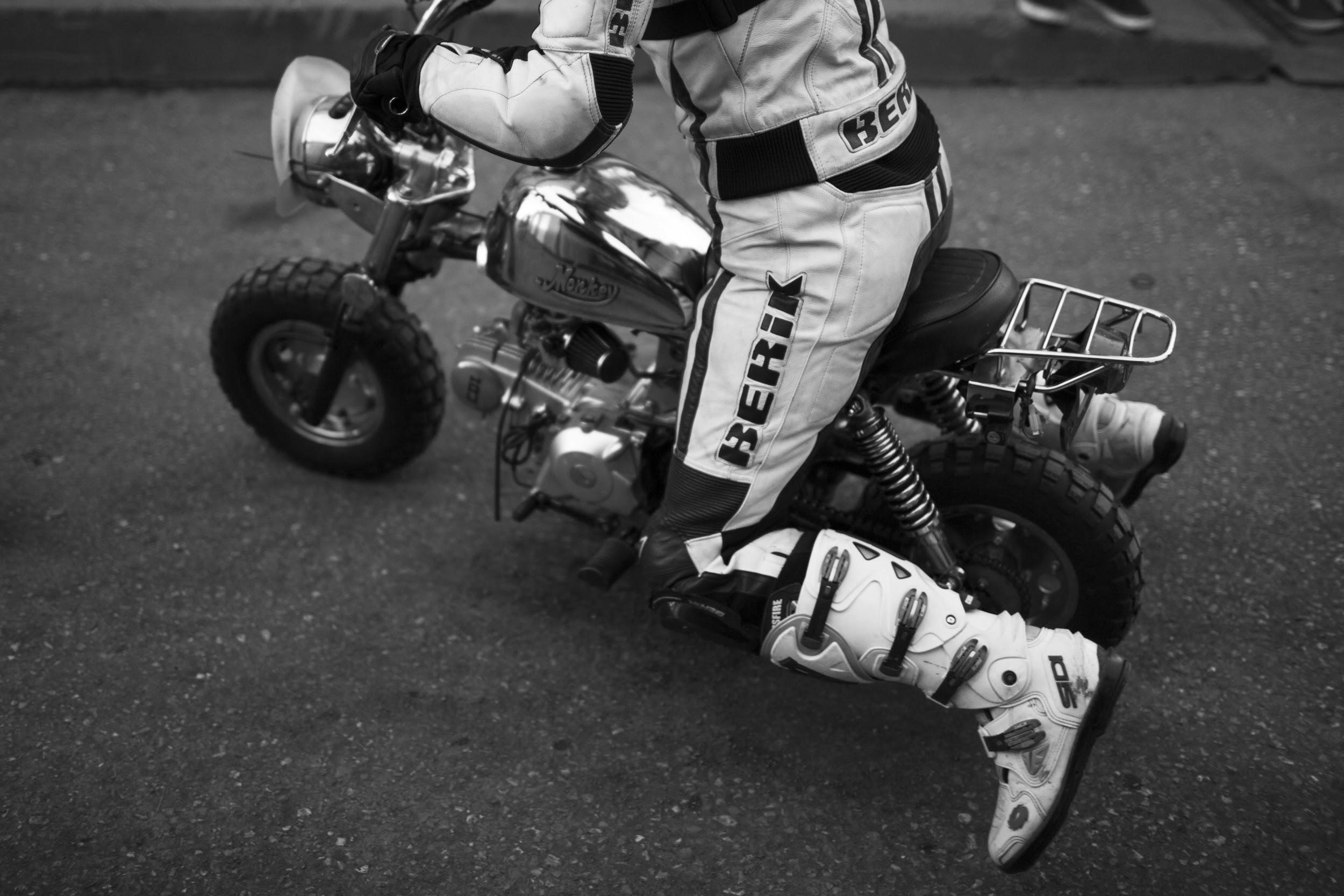
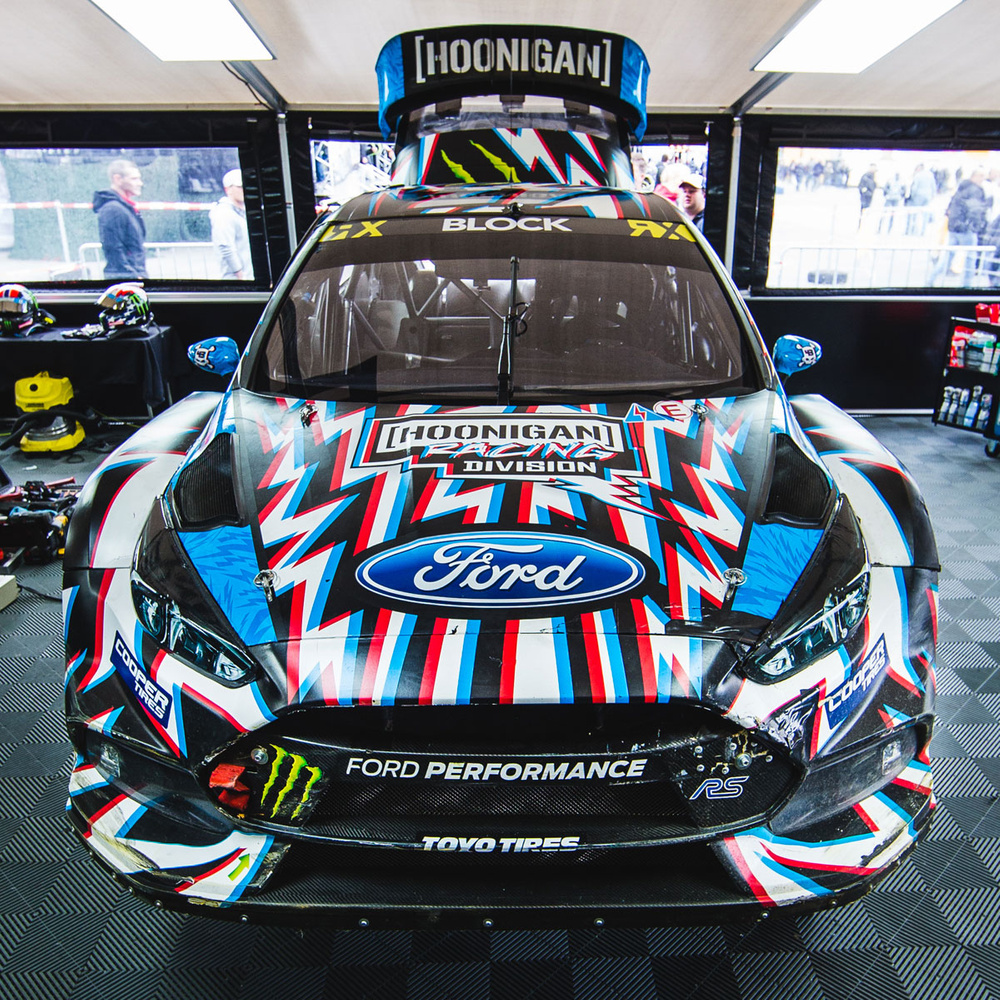
Photo: The Ken Block paint job – image courtesy DSC
The Artist: Death Spray Custom
Primary colours bleed across Ken Block’s Ford Focus RS. A lush spanner roll is subtly emblazoned with the Gucci logo. An Alpinestars racing suit is encoded with the viscera of a human nervous system. A Yamaha Super Téneré is rendered as a bedazzled battle-cruiser, brought to you in faux collaboration with esteemed fashion house Dior. Welcome to the world of Death Spray Custom aka David Gwyther.
It seems a bit simplistic to call David Gwyther an artist. He makes art – that’s for sure, but he’s so much more than that. Everything he makes seems to move. It is dynamic. It is playful. It exists in a world far removed from your traditional art gallery. And situated at a very British crossroads of car and bike culture, one that comes with a little side track that leads from skate and surf culture. As such there’s not many like him creating stuff in the UK.
The fact that David hails originally from the wet farmlands of West Wales is a hint to the roots of the Death Spray aesthetic. Running through everything he makes is a juxtaposition between the hi contrast colour and perceived glamour of motorsport – and cars and bikes in general – and the oily, dirty, mortally dangerous and unethical behaviour at the culture’s heart. Being surrounded by space and machines often leads to a preoccupation with internal combustion. Take notice of DSC. He elevates the motor to new aesthetic levels.
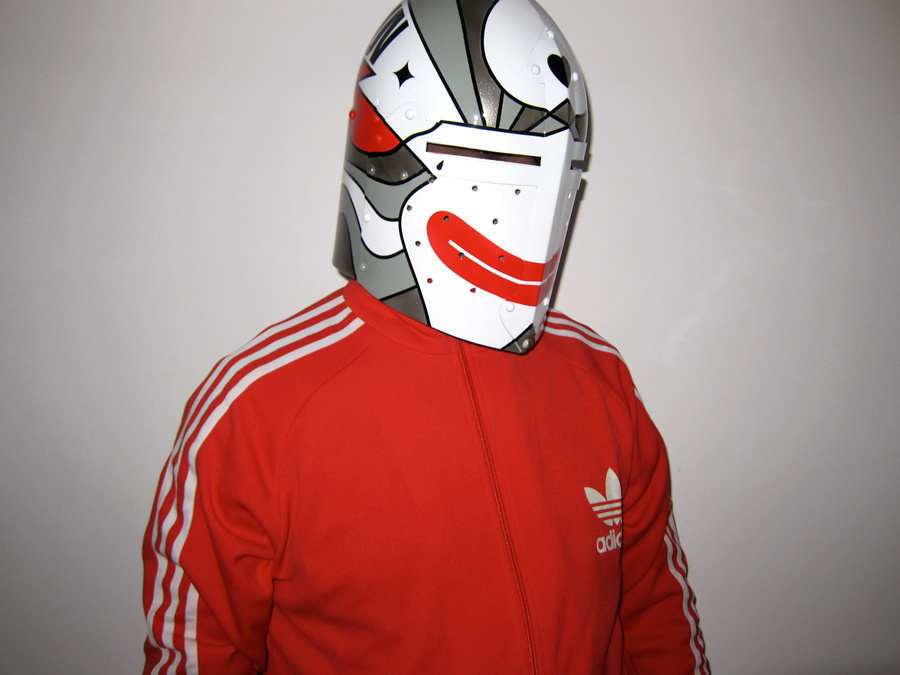
Photo: New Knights of Old. Image courtesy DSC
CLICK TO ENLARGE









